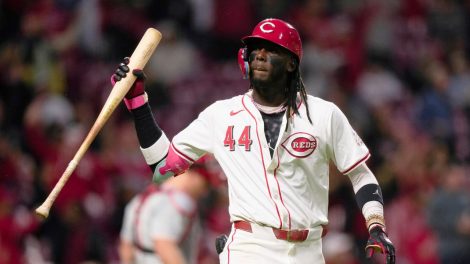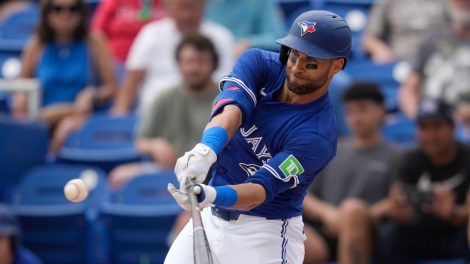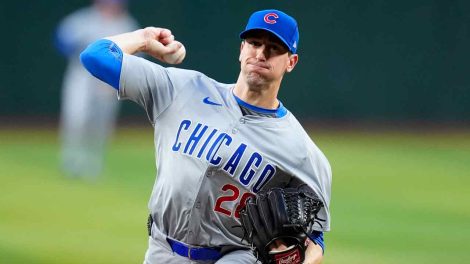TORONTO – The Toronto Blue Jays stepped out of their recent draft strategy comfort zone in selecting high school shortstop Jordan Groshans with the 12th overall pick in the 2018 draft Monday night.
In the first two drafts under GM Ross Atkins their three first-round picks – right-hander T.J. Zeuch in 2016, shortstop Logan Warmoth and right-hander Nate Pearson last year – were all college players. Even in previous years under former GM Alex Anthopoulos, who made prep pitchers a calculated priority, the Blue Jays hadn’t selected a high-school player in the first round since right-hander Phil Bickford in 2013.
Regardless of regime, the Blue Jays have had a lot of swing and miss in the first round with high-schoolers since picking Vernon Wells in 1997 and Alex Rios in 1999. Travis Snider, Kevin Ahrens and D.J. Davis each fell well short of expectations. Neither Bickford nor Tyler Beede signed. Supplemental first-round picks Aaron Sanchez and Noah Syndergaard are outliers in that regard, as the trickiest talent pool in the draft has brought them far more bust than boom.
"Obviously being a little bit younger and not having the experience of playing at the collegiate level, everybody’s development plan is a little bit different," Blue Jays scouting director Steve Sanders said in comparing the general profile of prep players versus collegians. "A lot of times players determine their own timelines of progression so all high-school players aren’t necessarily the same, just like all college players aren’t necessarily the same.
"By taking a player at a younger age, you’ve had slightly less time to watch him develop. While there’s some risk associated with that, we certainly feel good about taking Jordan and the trajectory we feel pretty good that he’s going to be that you need to be on from here on out."
[relatedlinks]
The Blue Jays fell back on a couple of their norms with their second-round pick, selecting Duke right-fielder Griffin Conine, the hard-hitting son of long-time big-leaguer Jeff becoming their latest bloodlines pick.
Their shift on Groshans, a product of Magnolia High School who at 6-foot-4 and 190 pounds may have to eventually move to third but projects as a potential middle of the order bat, didn’t come lightly. Area scout Brian Johnston, based in Austin, knew both the player and his family really well and the Blue Jays started tracking him fairly aggressively during last summer’s showcase circuit.
Groshans met with a number of people in the organization and when the Blue Jays visited the Texas Rangers in April, he met with Atkins and manager John Gibbons in the visiting clubhouse.
"We’ve seen a lot of Jordan," said Sanders.
That seemingly set the Blue Jays up to make him a priority Monday night, and even when highly touted lefty Matthew Liberatore and righty Brady Singer (who was a Blue Jays second-round pick in 2015 but didn’t sign) slipped, they didn’t deviate. Liberatore ended up going to the Rays at No. 16 with Singer to the Royals at 18.
"Ultimately we felt Jordan was the best fit for our pick," said Sanders. "But there were a number of other players, including some pitchers, that we certainly considered and had interest in, as well."
Groshans played some third base this season, too, and while some third-party evaluations of him suggest he projects to be only average defensively at short, he has a chance to be plus on the hot corner.
The key selling point, however, is his bat.
"We just feel Jordan has a lot of the attributes we look for both in his swing, his combination of contact, of power, plate discipline," said Sanders. "He’s got a great feel and approach in the box, he’s able to drive the ball to all fields and we’re confident that his offensive ability will certainly transfer with wood at the next level."
The 12th overall pick has an assigned value of $4,200,900 and makes up the majority of the Blue Jays’ $7,982,100 spending pool for picks in the first 10 rounds. Players selected in rounds 11-40 can receive a bonus of up to $100,000 with any overage counting against a team’s pool. Teams that exceed their bonus pool by 0-5 per cent are charged a tax of 75 per cent while overages beyond that threshold are penalized with the loss of future picks as well as an escalating tax.
The Blue Jays did some manipulating of their pool last year, signing a handful of players for less than their spot’s assigned value, reallocating the money to their two first rounders – shortstop Logan Warmoth got $25,000 over while right-hander Nate Pearson picked up an extra $150,000 – second-round catcher Hagen Danner ($456,800 above slot) and 14th round first baseman P.K. Morris ($106,500).
With Groshans, the Blue Jays probably have a pretty good idea of what hunting in new talent pools is going to cost them.
"We’re certainly confident," said Sanders, "we’ll be able to work something out."









